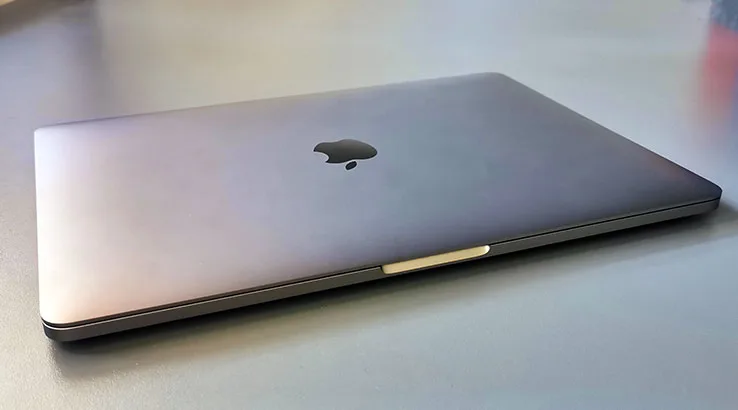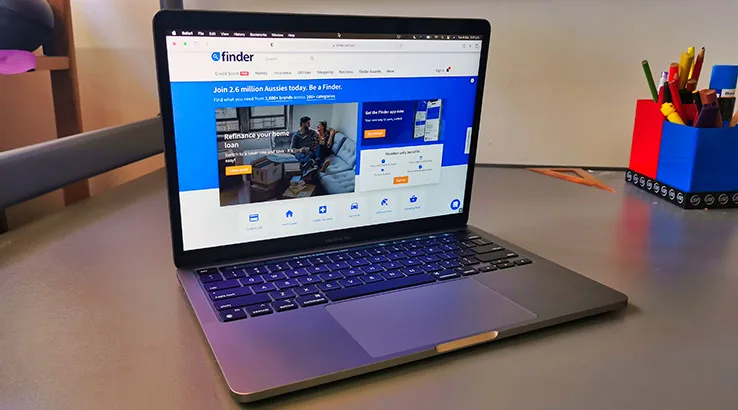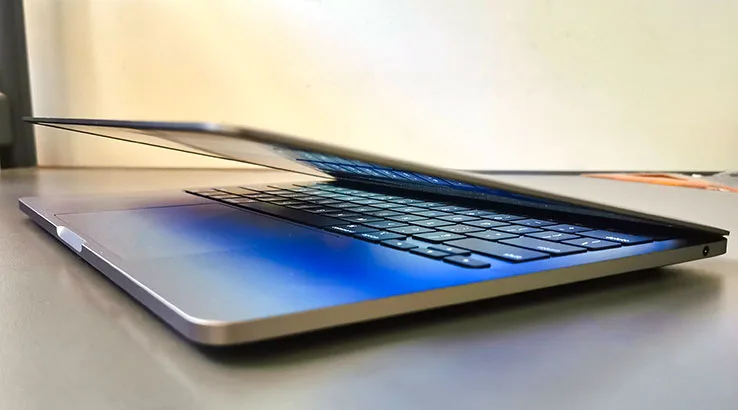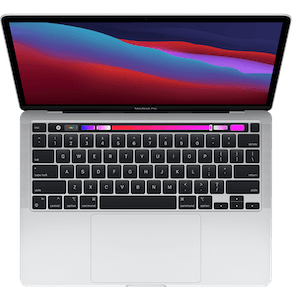Apple MacBook Pro 13 M1 review
Summary
Quick verdict: Apple's first MacBook Pro with its own Apple Silicon is a fast performer, but an unchanged design and small differences between it and the cheaper Air make it a tougher recommendation.
- M1 Silicon is astonishingly quick
- Better battery life than the MacBook Air M1
- Fans allow for heavier performance in a sustained way
- Touch Bar is still a contentious inclusion
- Intel apps eat battery power
- Why does a "Pro" laptop still only have two ports?
When Apple made the announcement that it was shifting its entire Mac line over to its own ARM-based "Apple Silicon" over a two-year period, with the promise that it would release at least one Apple Silicon Mac by the end of 2020, most pundits thought that meant we'd see a single Apple Silicon Mac this year, with more to follow in 2021 and 2022 as Apple wound down its Intel-based Mac plans.
Instead, Apple went for the trifecta. At the very entry level there's the desktop-style Apple Silicon Mac Mini. As the entry-level MacBook, there's the Apple MacBook Air M1 and as the current "flagship" of the Apple Silicon approach there's the Apple MacBook Pro 13 M1.
Which is an odd choice, because the 13-inch MacBook is in its own way the "entry" level of the MacBook Pro line.
That's perhaps the point because the M1 is only the first commercially available Apple Silicon chip we've seen. Better Apple Silicon is no doubt on the way, and that puts the Apple MacBook Pro 13 M1 in an unusual position.
It's an astonishingly powerful laptop, but it's not that much more powerful than the more affordable MacBook Air. With better models likely to emerge in the first half of 2021, it's a hard sell, especially given Apple has really done nothing with the external design.
Design
Design

Just as it did with the MacBook Air M1, Apple's designers didn't really stretch themselves all that hard when it came time to design the Apple MacBook Pro 13 M1.
In fact, any stretching that took place was probably accompanied by some yawning and reaching for doughnuts, because there's really no substantial external difference between the Apple MacBook Pro 13 M1 and the model with an Intel processor that Apple debuted just a few months ago. It's a design that Apple hasn't really changed for years in any substantial way.
Same 13.3-inch "retina" display with a 2560x1600 native resolution. Same bezels around it too, even though competitors have largely shifted to near edge-to-edge displays. Same "Magic" keyboard – that abominable Apple Butterfly keyboard is thankfully nowhere to be seen – with the same Touch Bar that you'll either use all the time thanks to integration or loathe thanks to the fact that it removes mechanical function keys. I'm in the latter crowd, but then I find most touch typists don't want or need a keyboard accessory that you explicitly have to look at in order to make any use of it.
You're also stuck with the same port inclusions, which equates to two Thunderbolt 3 ports on the left-hand side.
That was annoying on the MacBook Air M1 – at least throw one on each side for balance – but on a laptop that's ostensibly pitched at pro users who may need displays, networking, storage and other peripherals hanging off their laptop, just two ports feels genuinely archaic.
In the likewise creaky-and-old bucket is Apple's insistence on sticking to a simple 720p webcam. Apple's claim is that the new processor can adjust contrast and brightness for clearer images, but it's annoying that the only 1080p webcam Apple ships is stuck in an iMac only at this point in time.
Apple has made a lot of changes under the hood, but has totally played it safe when it comes to the external design of the Apple MacBook Pro 13 M1. That can't help feel like a bit of a missed opportunity, especially given the price premium Apple attaches to its Pro line notebooks.
Performance
Performance
- Apple M1 Silicon is seriously impressive
- Fans allow for more sustained load than the MacBook Air M1 – if you need it
- Intel app translation works pretty well
- Requires Internet for any rebuild, no exceptions
- iPad and iOS app compatible

The past few years of Apple MacBook Pro upgrades have largely rested on internal upgrades, which is still true for the Apple MacBook Pro 13 M1.
It's just that the upgrade in this case represents a seismic shift in Apple's strategy and an equally hefty bump in performance terms with the shift to Apple's new M1 "Apple Silicon" processor. It's an ARM-based processor, similar in architecture to the A series processors Apple throws into iPads and iPhones – more on that shortly – accompanied by MacOS 11, AKA "Big Sur".
Big Sur is capable of running Mac apps two ways. Apple's preferred strategy, and the one it'll push to developers on an ongoing basis is for what it calls "universal" apps. These provide code for both Intel-based Macs – so if you've got one you're not cast out into the wilderness – and ARM-based Macs, where Apple's future lies.
If you have older Intel-processor-only apps, they'll still run, via Apple's "Rosetta 2" app that kicks into gear asking to be installed the first time you try to run an Intel native app. That's the only time you really need to think about Rosetta 2, which otherwise just sits in the background quietly doing its thing for the apps it'll work for. It is worth noting that not every Intel app will run under Rosetta 2, and not surprisingly that's more likely if you're talking older Mac apps that might not see a jump to the universal app architecture.
Apple makes bold claims about how much better the M1 is than the Intel processors it's replacing. Its own claims are that it's up to 2.8x faster in CPU performance, 5x faster in graphics speed and 11x times faster for machine learning. It's well worth checking Apple's test environment there as it's not quite an, ahem, Apples to Apples comparison. The M1 units tested were running with 16GB of RAM, and that is an option, but the baseline for these new Apple MacBook Pro 13 M1 units is only 8GB.
That's the configuration Apple rather surprisingly sent me for review. Typically Apple review units are nearly always the tippy-top best models, because the company wants to show its best face. Sending out a unit with just 8GB of onboard RAM was a surprise. Could it still live up to Apple's hefty claims?
To get a picture of how well the M1 chip in the Apple MacBook Pro 13 M1 runs, I ran comparative benchmarks that I've run past prior MacBook models to give a relative performance indication. Here's how the Apple MacBook Pro 13 M1 compares:
The Apple MacBook Pro 13 M1 runs very well. It has a slight edge over the Apple MacBook Air M1 in benchmarks despite running on the same processor and same RAM inclusions.
That's almost certainly due to the presence of cooling fans in the Apple MacBook Pro 13 M1 that allow it to maintain CPU temperatures over a longer timeframe than the fanless Air design. Basically, the Air steps back to avoid cooking itself, while the Apple MacBook Pro 13 M1 can maintain full speed for a little longer, in return for a little fan noise.
Still, that difference isn't massive, even though it does punch up towards – and for some benchmarks above – the CPU found in the current top-tier MacBook Pro 16, a laptop that costs thousands of dollars more than the Apple MacBook Pro 13 M1.
It's also interesting to see how much overhead Rosetta 2 can involve, thanks to Geekbench 5's ability to run in either Apple Silicon or Intel modes. If you are stuck using older Intel architecture apps, they're going to run slower on the Apple MacBook Pro 13 M1 than their universal equivalents.
One feature that a significant number of pros loved about prior MacBooks is outright missing in this generation – the ability to use Boot Camp to create a MacBook Pro with a Windows 10 brain. It's just not part of Apple's story right now, although there is a universal version of Parallels that will at least let you run those apps. If you're working in a sensitive environment (or just somewhere with lousy Internet) it's also worth noting that Big Sur, the base OS for any Apple Silicon Mac cannot restore a full Mac without a digital sign-in online to Apple at least once.
What you do gain with the shift to an ARM-based Mac is a whole host of new apps, by way of iPadOS and iOS. It's possible to install new or previously purchased iPadOS or iOS apps onto an Apple Silicon Mac via the Mac App store, although not every app will appear, and there's a default towards iPad apps. That makes sense given the relative screen orientation of iPad apps against iOS apps, which appear as smaller columns when they load.
It's also a bit of a try-it-and-see environment, even some months after iOS/iPadOS apps added mouse and keyboard support. Some apps run fine, while others will lag or crash a lot. It's early days here in terms of Apple having one big happy family of apps, but that's not necessarily a reason to jump right in when you could wait until these issues are more ironed out.
Battery life
Battery life
- Better battery life than the Air, but still not quite up to Apple's claimed figures
- Easy all-day battery life for all but the heaviest apps
- Intel apps will likely drain power faster
- USB-C charging is easy

Apple differentiates the Apple MacBook Pro 13 M1 from the slightly cheaper Apple MacBook Air M1 via the inclusion of the Touch Bar, an internal fan and a higher specification battery. Not that Apple tells you how much more power it has, except via vague "up to" statements around usage scenarios. Apple's claims are that the Apple MacBook Pro 13 M1 can manage up to 17 hours of wireless web use and up to 20 hours of Apple TV app video playback.
I couldn't quite replicate these feats in my own tests, typically hitting around 13 hours of video playback for example. It's not a stretch to argue that Pro users are likely to want the Pro machine because they're going to push it harder, which creates a bit of a challenge.
I could get a day's use out of the Apple MacBook Pro 13 M1 without its battery conking out on me without issue, which wasn't always the case for the 13-inch Intel model Apple released earlier this year. That's a good thing, but again that slightly cheaper Apple MacBook Air M1 can also manage most of my daily workloads without too much issue.
Like the Air, if you're using Intel-based apps you can expect less battery life – this will vary a lot depending on how intense a workload those apps represent – but hopefully over time universal equivalents of most apps will appear and make that point moot.
Like all recent Macs, recharging is via USB-C and unlike the new iPhone 12 lines, you do still get a charger in the box.
Should you buy the Apple MacBook Pro 13 M1?
- Buy it if you must have Apple Silicon right now and need sustained computing power.
- Don't buy it if you can wait for the heftier and more capable Pro models.
The Apple MacBook Pro 13 M1 is a great little laptop in many ways, and in most respects it does live up to Apple's promises.
However, I can't help but think that most Pro users would be better off waiting for a more Pro-powered device unless that 13-inch form factor and sustained power throughput is vital to you. If you're always busy rendering complex 3D environments and want a tiny laptop, you won't go far wrong with the Apple MacBook Pro 13 M1.
However, for many Pro users you'll get a very similar experience from the Apple MacBook Air M1 while keeping a couple of hundred bucks in your wallet.
Apple could have made the difference far more stark with a proper redesign of the Apple MacBook Pro 13 M1, especially its connection ports, but it didn't opt to do so. For many Pro users that makes it a less appealing option, especially if the reality of 2020 has left you in lots of virtual meetings where the Apple MacBook Pro 13 M1's 720p webcam won't quite make you look your best.
I can't claim insider knowledge (though I'm sure Apple PR could pass my details through to Tim Cook if they were so inclined), but it's assured we'll see more Apple Silicon lines in early to mid 2021. That's likely to include an upgraded Pro 16 model with more ports. If you need an upgrade with more Pro power, it's arguably worth holding your powder and waiting for that, or saving a little and grabbing the Air instead.
Pricing and availability
Specifications
General
Display
Features
Images: Alex Kidman
More Finder reviews
- Apple HomePod 2nd Gen review: Yes, it’s better
- Creality Ender-3 S1 Pro Review: Plenty of creative potential, but you’ll need patience too
- Apple Mac Mini M2 Pro review: A tale of two computers
- Apple MacBook Pro M2 Max 16-inch review: Next-level power
- HTC Vive XR Elite: Is this the perfect mix of Flow and Pro?

